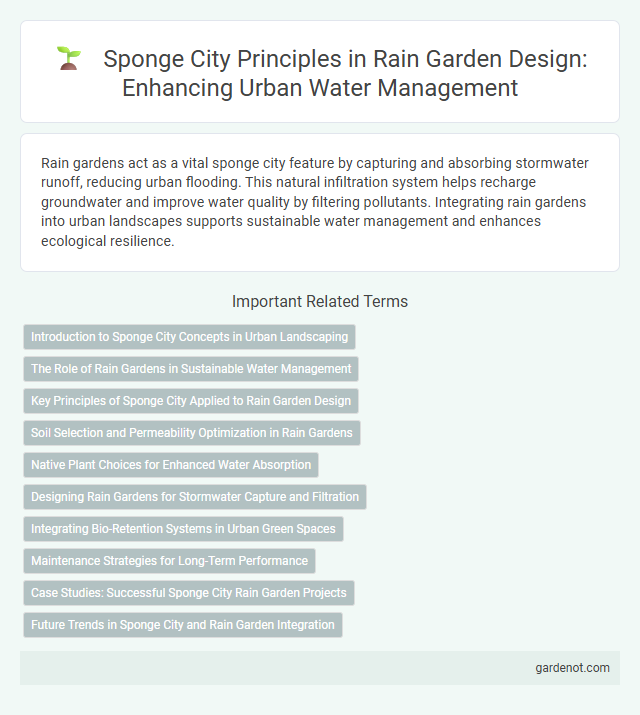Rain gardens act as a vital sponge city feature by capturing and absorbing stormwater runoff, reducing urban flooding. This natural infiltration system helps recharge groundwater and improve water quality by filtering pollutants. Integrating rain gardens into urban landscapes supports sustainable water management and enhances ecological resilience.
Introduction to Sponge City Concepts in Urban Landscaping
Sponge city concepts in urban landscaping emphasize the integration of permeable surfaces, rain gardens, and green infrastructure to enhance stormwater absorption and reduce urban flooding. These designs mimic natural water cycles by capturing, storing, and gradually releasing rainwater, promoting groundwater recharge and improving water quality. Implementing sponge city principles supports sustainable urban development by mitigating runoff and increasing resilience against extreme weather events.
The Role of Rain Gardens in Sustainable Water Management
Rain gardens play a critical role in sustainable water management by enhancing urban resilience against stormwater runoff and reducing the burden on municipal drainage systems. These bio-retention systems utilize native vegetation and soil layers to absorb and filter rainwater, improving groundwater recharge and minimizing pollutants entering natural waterways. Integrating rain gardens within sponge city frameworks contributes significantly to flood mitigation, water quality improvement, and urban biodiversity enhancement.
Key Principles of Sponge City Applied to Rain Garden Design
Rain garden design in sponge cities emphasizes key principles such as natural water infiltration, pollutant filtration, and stormwater retention to manage urban runoff effectively. Integrating native vegetation and permeable soil media enhances groundwater recharge while reducing surface flooding. These practices align with sponge city goals by mimicking natural hydrological cycles and improving urban resilience against extreme weather events.
Soil Selection and Permeability Optimization in Rain Gardens
Soil selection in rain gardens is critical for maximizing water infiltration and supporting the sponge city concept by enhancing urban flood resilience. Utilizing a mix of sandy loam and organic matter improves permeability, enabling efficient stormwater absorption and reducing surface runoff. Optimizing soil permeability directly contributes to groundwater recharge and mitigates urban heat island effects through enhanced soil moisture retention.
Native Plant Choices for Enhanced Water Absorption
In sponge city designs, native plant choices play a critical role in enhancing water absorption and improving stormwater management. Deep-rooted indigenous plants like switchgrass, sedges, and wildflowers increase soil permeability and promote infiltration, reducing runoff. These plants are adapted to local climate conditions, supporting ecological balance and maximizing the rain garden's efficiency in urban water retention.
Designing Rain Gardens for Stormwater Capture and Filtration
Rain gardens designed for stormwater capture and filtration are essential components of sponge city initiatives, utilizing native vegetation and engineered soil layers to absorb and cleanse runoff. These systems reduce urban flooding by slowing water flow, promoting infiltration, and filtering pollutants before they reach waterways. Optimizing rain garden design involves selecting plant species with high uptake capacity and incorporating bio-retention zones to enhance the efficiency of stormwater management.
Integrating Bio-Retention Systems in Urban Green Spaces
Integrating bio-retention systems within urban green spaces enhances rain gardens' effectiveness by naturally filtering stormwater through layers of soil, plants, and microbes. These sponge city features reduce urban flooding, improve water quality, and recharge groundwater by capturing runoff from impervious surfaces. By prioritizing native vegetation and engineered soil media, bio-retention systems create sustainable, resilient landscapes that support biodiversity and mitigate heat island effects.
Maintenance Strategies for Long-Term Performance
Rain gardens are essential components of Sponge City initiatives, designed to manage stormwater runoff and enhance urban water resilience. Effective maintenance strategies include regular inspection for sediment buildup, removal of invasive plants, and ensuring the infiltration soil remains permeable to maximize water absorption. Incorporating native vegetation and seasonal monitoring helps sustain the rain garden's long-term performance and ecological benefits.
Case Studies: Successful Sponge City Rain Garden Projects
Sponge city rain garden projects in cities like Beijing and Wuhan showcase effective urban water management through permeable surfaces and native vegetation, significantly reducing stormwater runoff and improving groundwater recharge. These case studies highlight the integration of rain gardens with green infrastructure to mitigate urban flooding and enhance biodiversity within densely populated areas. Data from Wuhan's pilot districts report up to a 30% decrease in surface runoff, demonstrating the practical benefits of sponge city principles in real-world applications.
Future Trends in Sponge City and Rain Garden Integration
Future trends in Sponge City development emphasize the integration of rain gardens to enhance urban stormwater management by increasing infiltration and reducing runoff pollution. Advances in green infrastructure design and smart monitoring technologies will enable dynamic adaptation of rain gardens to varying rainfall patterns, improving resilience against climate change impacts. Collaborative urban planning incorporating rain gardens within Sponge City frameworks is projected to promote sustainable water cycles and biodiversity in metropolitan environments.
Sponge city feature Infographic

 gardenot.com
gardenot.com